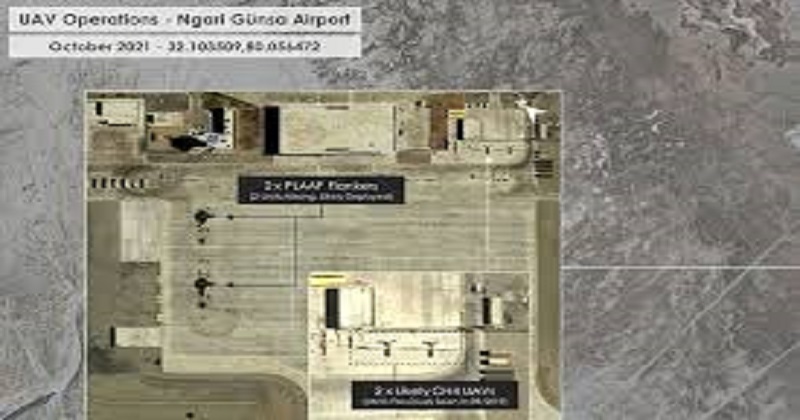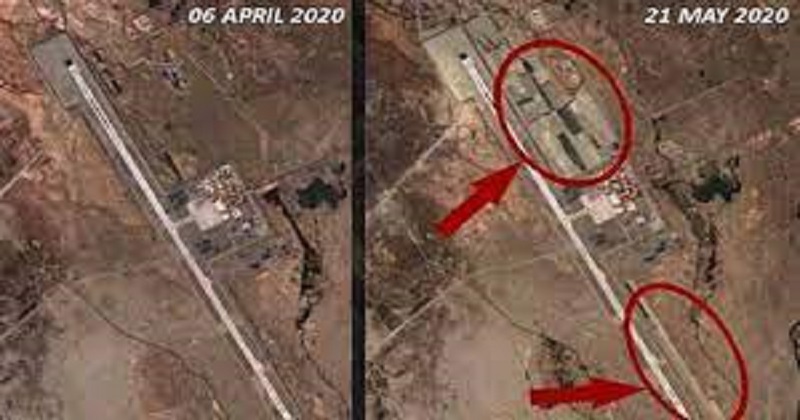
In satellite imagery from October 2021, China’s People’s Liberation Army Air Force or PLAAF can be seen using unmanned aerial vehicles (UAVs) and fighter jets from its Ngari Gunsa airbase, just 200 kilometres from the Pangong Lake. This PLAAF base, which also serves as a civilian airport, is in Tibet’s Ngari prefecture, not far from the Line of Actual Control (LAC). In 2010, the Chinese operationalized the base, which was built at an elevation of 14,000 feet.
Satellite images posted by open source intelligence handle @detrasfa_ on Twitter indicate that the PLAAF has deployed UAVs – CH4s, most likely – at the airbase. The satellite image of the airbase shows two unmanned aerial vehicles, deployed since at least August of this year. The base was built as hardened aircraft shelters in February 2021, as shown in satellite images from early this year. Known also as blast pens, hardened shelters shield jet fighters from bombs and missiles fired by their enemies. According to experts, the construction of hardened aircraft shelters at the airbase indicates China is planning to expand its presence there, including drones, over the next few years to counter India’s deployments in Ladakh.

During the standoff in eastern Ladakh, the military expanded the base, which began sometime in early 2020. During the standoff in May 2020, the PLAAF base saw rapid construction activity. Satellite imagery from April and May 2020 revealed construction in a wide area parallel to the runway. Various earthworks were visible in a satellite image taken on 15 May next to the 4,500-metre runway of the airbase. Back then, reports said it could be a ‘second taxi-track or a secondary tarmac’. The satellite imagery from May 2020 also shows at least four PLAAF fighter jets, possibly J-11s or J-16s (Chinese variants of the Russian Su-27).

The first time this detachment of fighter jets was seen at the Ngari Gunsa airbase in December, just months before China surprised India by deploying thousands of soldiers, backed by heavy equipment, along the LAC in eastern Ladakh. According to a South China Morning Post report, a Chinese military source said the PLAAF had deployed its J-16s at Ngari Gunsa for ‘regular training’ but chose to retain the aircraft at the base during the standoff. Additionally, China had deployed additional fighters in Hotan, north of Ladakh. China Aerospace Studies Institute (CASI), based at the US Air Force’s Air University in Alabama, reports that the PLAAF deploys up to 12 variants of the Flanker (Su-27) at its base in Hotan. Satellite images dated 14 June, however, show that China has deployed ‘an additional 24 aircraft’ at this airbase.
Read more: Shia Muslims will be attacked everywhere by IS: Claims revealed
As part of efforts to increase its presence along the LAC, China is also building a helicopter base in Aksai Chin, 130 kilometres east of Galwan Valley, where 20 Indians and dozens of Chinese soldiers were killed in clashes on 15 June last year. A military base and an airstrip – the highest in the world – are located at Daulat Beg Oldie, about 147 km away. Helicopter bases are part of China’s large infrastructure buildup drive launched last year, which includes expanding airbases near the LAC to accommodate fighter jets and unmanned aerial vehicles on the Tibetan Plateau.

Post Your Comments